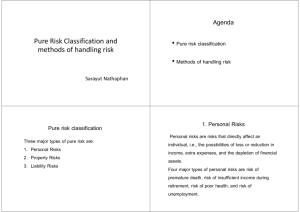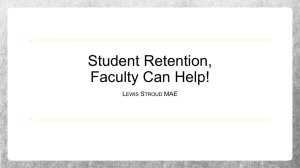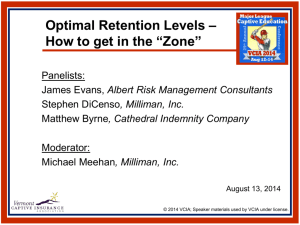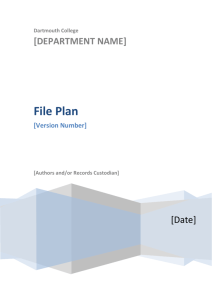Topic 2. Risk and Risk Management
advertisement
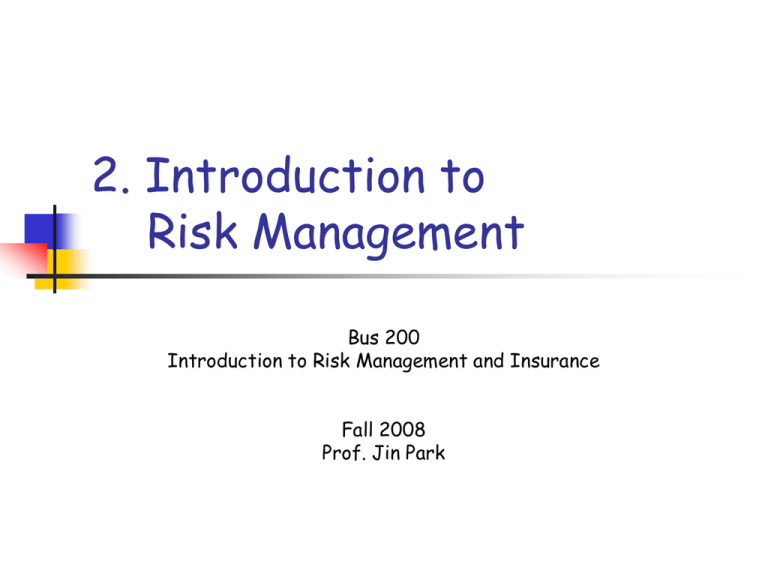
2. Introduction to Risk Management Bus 200 Introduction to Risk Management and Insurance Fall 2008 Prof. Jin Park Overview Definition & Objectives Process Risk Management Technique Control vs. Finance More on Risk Finance Retention, Captive, Insurance, Transfer Definition and Objectives Risk Management A systematic process for managing (pure) risks faced by an individual or organization. Loss Exposure Pre-loss vs. Post-loss risk management Ay situation or circumstance in which a loss is possible regardless of whether a loss occurs. Objectives Why? Management’s job Reduce earnings volatility Maximize shareholder’s value Promote job and financial security Risk and Relative Return Zone 1 Insufficient Risk Taking Zone 2 Optimal Risk Taking RiskAdjusted Return Risk Zone 3 Excessive Risk Taking Risk Management Process Risk Management Process Risk Management Process The Process Step 1 - Identification Step 2 – Evaluation Frequency Severity Step 3 – Risk Management Selection Loss exposures Methods Control vs. Finance Prevention vs. Reduction Step 4 – Implementation and Monitor Evaluation Tools Risk mapping A graphical presentation of potential frequencies and severities of identified loss exposures faced by individual/organization Critical issue tolerance boundary or risktolerance boundary Prioritize risks Risk management matrix Risk Mapping EE’s petty theft Auto liability Vandalism Job related injuries System failure Frequency Robbery Owner’s disability Fire on warehouse Default on payment Severity Tornado Flood on warehouse Risk Management Matrix High Prevention Retention Avoidance Low Retention Reduction Insurance Low High Frequency Severity Risk Management Techniques Risk Control Goals Risk control options Avoidance Loss control Prevention Reduction Pre-loss risk control Post-loss risk control Risk Financing Goals Risk financing options Retention How? Transfer Insurance Non-insurance Risk Financing - Retention A method of funding losses using internal money No purchase of insurance Retention with insurance What determines the retention decision? Frequency & severity of expected losses No other effective method available Costs and availability of insurance MMP, Health care insurance Highly predictable losses Self-confidence or degree of risk aversion Failure to identify Risk Financing - Retention What determines the retention level? Degree of risk aversion Financial condition Ability to diversify the retained risk Potential cost/benefit Costs and availability of insurance Ability to administer a retention program in a cost effective manner Risk Financing - Retention Self-Insurance, Captive, RRG Self-Insurance Captive A form of self-insurance through a wholly owned subsidiary (insurance company) created to provide insurance to the parent companies Pure captive, Group captive, Risk Retention Group Which one? UPS vs. IRS Transfer - Insurance Advantages Less uncertainty Loss control services. Eligible expenses Non-taxable insurance proceeds. Disadvantages High insurance premium. Moral and morale hazards. Time and effort. Insurance may not be available. Dependable No benefit of loss control Non-Insurance Transfer Methods of transferring risk to another party other than by insurance Contracts Hold harmless agreements Leases Non-Insurance Transfer Advantages May be able to transfer losses that are otherwise not commercially insurable. Noninsurance transfers may cost less than insurance. May be able to shift loss to someone who is in a better position to exercise loss control. Disadvantages Transfer may fail for legal reasons Transferee may be unable to pay the loss May not reduce insurance costs if insurer does not give credit for the transferred risk

